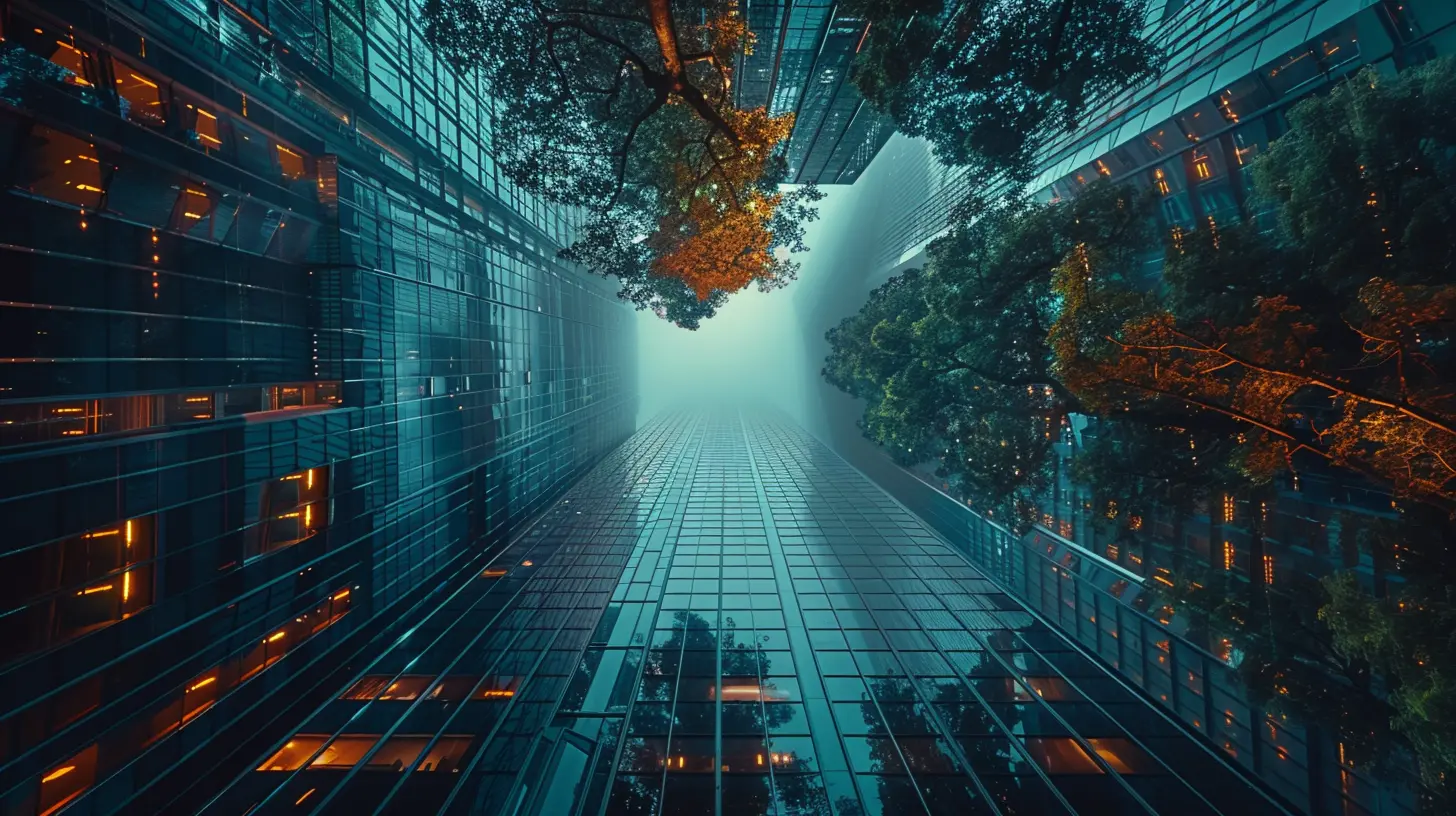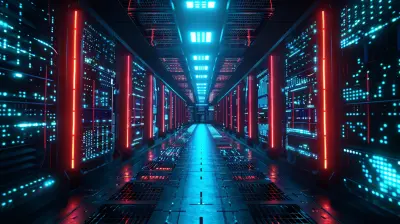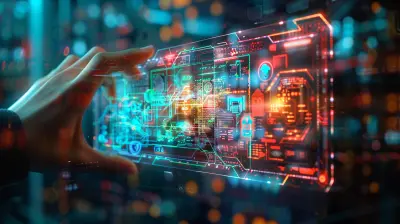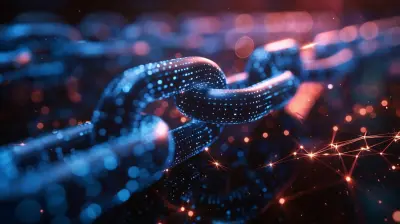The Intersection of Digital Transformation and Sustainability
3 January 2025
In today's rapidly evolving world, two powerful forces are shaping the future: digital transformation and sustainability. It’s like watching two rivers merge into one, creating an unstoppable stream of innovation and environmental consciousness. The question is no longer whether businesses should embrace these trends, but how they can intertwine them to create a better, greener future.
So, what happens when digital transformation, the engine of the modern world, meets sustainability, the moral compass of our time? Let's dive right in.

What is Digital Transformation?
Before we get into the nitty-gritty of how digital transformation and sustainability intersect, let's first break down what we mean by digital transformation.In simple terms, digital transformation is the process of adopting digital technologies to fundamentally change how businesses operate and deliver value to their customers. It’s more than installing new software or upgrading legacy systems. It’s about rethinking business models, reinventing operations, and reshaping customer experiences in the digital age.
Think about how streaming platforms like Netflix revolutionized the entertainment industry, or how ride-sharing apps like Uber transformed transportation. These are prime examples of how digital transformation can shake up entire industries.
But, it's not just about adopting new technology for the sake of it. It's about using that technology to solve problems, streamline processes, and drive innovation. And, when done right, it can also help businesses reduce their carbon footprint and contribute to a more sustainable future.

Sustainability: The Need of the Hour
Now, let’s talk about sustainability. The term has been thrown around a lot lately, but it's more than just a buzzword. At its core, sustainability is about meeting our present needs without compromising the ability of future generations to meet theirs.In simpler terms, it's about making sure that the world we live in stays habitable, not just for us, but for our children and their children. This could mean reducing greenhouse gas emissions, using resources more efficiently, or ensuring that products are made in an environmentally-friendly way.
You’ve probably heard about companies pledging to be "carbon neutral" or reducing their reliance on single-use plastics. These are all efforts towards sustainability. But here’s the kicker – sustainability isn’t just good for the planet. It’s also good for business. Consumers today are more environmentally conscious than ever, and they’re willing to support brands that share their values.

The Intersection of Digital Transformation and Sustainability
So, where do digital transformation and sustainability meet? It turns out, they’re closer than you might think.Digital transformation can be a key enabler of sustainability. In fact, many of the digital innovations we see today have the potential to significantly reduce environmental impact. From cloud computing to artificial intelligence, these technologies are helping companies become more efficient, reduce waste, and lower their carbon emissions.
Let’s explore a few ways digital transformation can drive sustainability:
1. Optimizing Supply Chains
One of the biggest challenges businesses face when it comes to sustainability is managing their supply chains. The production, transportation, and distribution of goods often leave a significant carbon footprint.However, digital technologies like the Internet of Things (IoT) and blockchain are transforming supply chains. IoT sensors can monitor energy usage, water consumption, and emissions in real time, allowing businesses to identify inefficiencies and make immediate corrections. Blockchain, on the other hand, provides transparency and traceability, ensuring that products are sourced responsibly and sustainably.
Imagine a world where you can scan a product and instantly know the environmental impact of every step in its production process. That’s the power of digital transformation at work.
2. Reducing Energy Consumption
Energy consumption is another area where digital transformation can have a major impact. Traditional energy grids are notoriously inefficient, often leading to wasted energy and higher emissions.But with the rise of smart grids and AI-powered energy management systems, businesses can optimize their energy usage. For instance, AI can analyze data from sensors and automatically adjust heating, cooling, and lighting systems to minimize energy consumption without sacrificing comfort.
And it’s not just businesses that benefit. At home, smart thermostats and energy-efficient appliances are helping individuals reduce their carbon footprint, too.
3. Remote Work and Virtual Collaboration
The COVID-19 pandemic was a wake-up call for many businesses, forcing them to adopt remote work and digital collaboration tools. While many of us were initially skeptical, it turns out that remote work can actually be good for the environment.By reducing the need for commuting and office space, companies can significantly cut down on their carbon emissions. Video conferencing tools, cloud-based collaboration platforms, and virtual meeting software have all played a role in making this shift possible.
Think about it – every time you attend a virtual meeting instead of flying across the country, you're reducing your carbon footprint. And with more companies adopting hybrid work models, virtual collaboration is here to stay.
4. Circular Economy and Digital Technologies
The concept of a circular economy is gaining traction as a more sustainable alternative to the traditional linear economy (take, make, waste). In a circular economy, products are designed to be reused, repaired, and recycled – minimizing waste and reducing the need for new resources.Digital technologies are playing a crucial role in enabling this shift. For example, 3D printing allows for the creation of products using recycled materials, while machine learning can predict when equipment will need maintenance, extending its lifespan.
Furthermore, platforms powered by AI and big data can help businesses track the lifecycle of their products, ensuring that materials are reused or recycled at the end of their life. In other words, digital transformation is helping businesses move from a throwaway culture to one where resources are valued and reused.
5. Data-Driven Sustainability
Data is often referred to as the "new oil," but unlike oil, data can be a powerful force for good when it comes to sustainability. The explosion of data in recent years, combined with advancements in analytics and machine learning, is providing businesses with unprecedented insights into their environmental impact.For example, companies can use data to monitor their energy usage, emissions, and waste in real-time, allowing them to make more informed decisions about how to reduce their environmental footprint. Predictive analytics can also help businesses anticipate future environmental challenges and develop strategies to mitigate risks.
And it’s not just about reducing negative impacts. Data can also be used to identify new opportunities for sustainable innovation, such as developing eco-friendly products or optimizing resource usage.
6. Digital Twins for Environmental Monitoring
Here’s where things get really cool. Digital twins – virtual replicas of physical objects or systems – are being used to monitor and predict environmental conditions in real-time. By creating a digital twin of a factory, for example, businesses can monitor emissions, energy consumption, and resource usage, and make adjustments to reduce their environmental impact.But the applications go beyond factories. Digital twins are being used to monitor entire cities, helping urban planners design more sustainable infrastructure, optimize transportation systems, and reduce pollution.
In a sense, digital twins are like having a crystal ball that lets you see the environmental impact of your operations before they happen – and make changes for the better.

The Challenges of Merging Digital Transformation with Sustainability
Of course, the intersection of digital transformation and sustainability isn’t without its challenges. For one, digital technologies themselves can have a significant environmental impact. Data centers, for example, consume massive amounts of energy, and the production of electronic devices often requires the use of rare earth metals and other finite resources.However, many companies are working to address these challenges. For instance, tech giants like Google and Microsoft are investing in renewable energy to power their data centers, while researchers are exploring ways to reduce the environmental impact of electronic manufacturing.
Another challenge is ensuring that digital transformation efforts are truly aligned with sustainability goals. Implementing new technology for the sake of innovation won’t necessarily lead to positive environmental outcomes. Businesses must be intentional about how they use digital tools to drive sustainability, and they must be willing to adapt their strategies as new technologies emerge.
The Future: A Greener, Smarter World
As digital transformation continues to reshape industries, the potential for creating a more sustainable world is immense. We’re already seeing the benefits in areas like energy efficiency, supply chain optimization, and the circular economy, and the pace of innovation shows no signs of slowing down.But for businesses to truly harness the power of digital transformation for sustainability, they need to adopt a mindset of continuous improvement. It’s not enough to implement a few green initiatives and call it a day. Instead, companies must constantly evaluate their environmental impact, experiment with new technologies, and adapt to changing circumstances.
In the end, the intersection of digital transformation and sustainability isn’t just about saving the planet – it’s about building a future where technology and nature coexist in harmony. And that’s a future worth striving for.
all images in this post were generated using AI tools
Category:
Digital TransformationAuthor:

Reese McQuillan
Discussion
rate this article
24 comments
Nolan Bailey
This article brilliantly highlights the synergy between digital transformation and sustainability. It's fascinating to consider how innovative technologies can drive eco-friendly practices while reshaping industries. I'm eager to explore the potential for sustainable solutions that emerge from this intersection and how they can reshape our future.
February 16, 2025 at 7:25 PM

Reese McQuillan
Thank you for your insightful comment! I'm glad you found the article engaging and recognize the exciting potential at the intersection of digital transformation and sustainability.
Lysara Kearns
Great read! It’s exciting to see how digital transformation can drive sustainability efforts forward. Embracing technology not only boosts efficiency but also fosters a greener future. Let’s keep pushing for innovative solutions!
February 1, 2025 at 11:29 AM

Reese McQuillan
Thank you for your insightful comment! I completely agree—leveraging technology is key to driving sustainability and innovation forward. Let's continue to explore these possibilities together!
Zoey Estes
This article effectively highlights how digital transformation can drive sustainability efforts by optimizing resource management and enhancing operational efficiency, paving the way for a greener, tech-driven future.
January 26, 2025 at 7:48 PM

Reese McQuillan
Thank you for your insightful comment! I'm glad you found the article's focus on digital transformation and sustainability impactful.
Abigail Jenkins
This article highlights a crucial synergy between digital transformation and sustainability. Embracing technology can significantly enhance resource efficiency and reduce carbon footprints. By leveraging innovations like AI and IoT, organizations can drive sustainable practices while achieving operational excellence. It's an exciting time for businesses committed to a greener future through digital initiatives.
January 22, 2025 at 8:13 PM

Reese McQuillan
Thank you for your insightful comment! I completely agree that the integration of technology not only boosts efficiency but also plays a vital role in promoting sustainability. It's an exciting opportunity for organizations to innovate while contributing to a greener future.
Duke Murphy
Ah, yes, because nothing screams sustainability like a million servers buzzing away in a climate-controlled room. Who knew saving the planet involved so many power cords?
January 18, 2025 at 5:59 AM

Reese McQuillan
You raise a valid point! Balancing digital transformation with sustainability is crucial, and we must prioritize energy-efficient technologies and renewable energy sources to minimize our environmental impact.
Jolene Wilkins
Digital transformation and sustainability? Sounds like my phone trying to save battery while I binge-watch cat videos! If only tech could help me recycle everything I’ve hoarded over the years... maybe there’s an app for that! #TechForGood #HelpMeClearMyCloset
January 14, 2025 at 9:12 PM

Reese McQuillan
Haha, love the analogy! While tech can’t declutter your closet, digital solutions can indeed help streamline recycling and promote sustainability. Let’s hope for more innovative apps to tackle our hoarding habits! #TechForGood
Paula McNaughton
This article insightfully explores how digital transformation can drive sustainability efforts, highlighting innovative technologies that reduce environmental impact while promoting efficiency and responsible resource management. Great read!
January 12, 2025 at 6:02 AM

Reese McQuillan
Thank you for your positive feedback! I'm glad you found the article insightful in connecting digital transformation with sustainability.
Fennec Monroe
Integrating digital transformation with sustainability is essential for achieving a greener, efficient future.
January 10, 2025 at 1:41 PM

Reese McQuillan
Absolutely! Integrating digital transformation with sustainability not only enhances efficiency but also drives innovation towards a more sustainable future.
Runevale McNaughton
Digital transformation is not just a trend; it’s a necessity. Businesses must harness technology not only to drive efficiency but also to champion sustainability. Embracing this intersection is crucial for future-proofing our economy and planet.
January 10, 2025 at 5:59 AM

Reese McQuillan
Absolutely! Embracing digital transformation is essential for fostering sustainability and ensuring long-term resilience in both business and environmental practices.
Amos Kirkpatrick
Embracing digital transformation not only drives innovation but also empowers sustainable practices. Together, they pave the way for a brighter future, where technology and environmental stewardship work hand in hand for a better world.
January 9, 2025 at 7:21 PM

Reese McQuillan
Thank you for your insightful comment! I completely agree—digital transformation and sustainability are indeed interconnected and essential for fostering a brighter, more responsible future.
Zora McNeal
This article beautifully highlights the crucial relationship between digital transformation and sustainability. Embracing innovative technologies can indeed pave the way for a greener future, fostering responsible growth while addressing our planet's pressing challenges. Great insights!
January 9, 2025 at 11:26 AM

Reese McQuillan
Thank you for your thoughtful comment! I'm glad you found the insights on the connection between digital transformation and sustainability valuable.
Xander McGee
Great insights on how digital transformation can drive sustainability! It's encouraging to see technology playing a pivotal role in creating a more sustainable future. Looking forward to more discussions on this crucial intersection.
January 9, 2025 at 3:53 AM

Reese McQuillan
Thank you for your feedback! I'm glad you found the insights valuable. Excited for more discussions on this vital topic!
Oscar McElroy
Embrace innovation for a greener future—technology and sustainability can thrive together!
January 8, 2025 at 7:58 PM

Reese McQuillan
Absolutely! Embracing innovation is key to achieving a sustainable future; technology can drive efficient solutions that benefit both the planet and society.
Graham Bryant
Embracing digital transformation isn't just about innovation; it's a vital step towards a sustainable future. By leveraging technology, we can drive efficiency, reduce waste, and create solutions that benefit both our planet and our economy. The time for bold action is now!
January 8, 2025 at 4:39 AM

Reese McQuillan
Thank you for highlighting the critical link between digital transformation and sustainability. Embracing technology is indeed essential for creating efficient, eco-friendly solutions that benefit our planet and economy simultaneously. Your call for action resonates strongly!
Capri Ross
Great insights on the synergy between digital transformation and sustainability! Emphasizing how technology can drive eco-friendly practices is crucial. Consider highlighting specific case studies that showcase successful implementations, as real-world examples can inspire more organizations to adopt sustainable digital strategies effectively.
January 7, 2025 at 8:47 PM

Reese McQuillan
Thank you for your feedback! I appreciate your suggestion to include case studies; real-world examples can indeed enhance the discussion and inspire action.
Grayson McRae
This article insightful highlights how digital transformation not only drives innovation but also fosters sustainable practices, creating a harmonious balance between technology and environmental responsibility.
January 7, 2025 at 1:26 PM

Reese McQuillan
Thank you for your feedback! I'm glad you found the connection between digital transformation and sustainability insightful. It's crucial for fostering innovation while being environmentally responsible.
Sylph Summers
Empowering sustainable growth through digital innovation.
January 7, 2025 at 3:20 AM

Reese McQuillan
Thank you! Emphasizing digital innovation is key to achieving sustainable growth and addressing environmental challenges effectively.
Zephyrian Bell
Digital transformation is not just a technological shift; it's a fundamental opportunity to drive sustainability. By integrating innovative solutions, businesses can enhance efficiency and reduce their environmental impact, proving that progress and responsibility can go hand in hand.
January 6, 2025 at 7:23 PM

Reese McQuillan
Thank you for highlighting this crucial point! Indeed, digital transformation not only advances technology but also empowers businesses to pursue sustainable practices, creating a win-win for both efficiency and the environment.
Orionyx Daniels
I'm intrigued by how digital transformation can drive sustainability efforts. What innovative technologies are emerging to enhance eco-friendly practices, and how can businesses effectively balance growth with environmental responsibility?
January 5, 2025 at 7:32 PM

Reese McQuillan
Digital transformation fosters sustainability through technologies like IoT, AI, and blockchain, enabling efficient resource management and reduced waste. Businesses can balance growth and environmental responsibility by integrating sustainable practices into their core strategies, leveraging data analytics for informed decision-making, and engaging in circular economy models.
Josephine Bass
Empowering a sustainable future through innovative digital solutions!
January 5, 2025 at 12:46 PM

Reese McQuillan
Thank you! I'm glad you found the article highlights the crucial link between digital innovation and sustainability. Together, we can drive meaningful change!
Marissa Shaffer
Great insights on tech and sustainability!
January 4, 2025 at 9:32 PM

Reese McQuillan
Thank you! I'm glad you found the insights valuable.
Cassandra McGarvey
Great read! It's exciting to see how digital transformation can drive sustainability efforts and create a greener future for all!
January 3, 2025 at 9:40 PM

Reese McQuillan
Thank you! I'm glad you found it engaging. Digital transformation truly has the potential to enhance sustainability and drive positive change.
Julia McGonagle
Turning bytes into green: saving the planet, one pixel at a time!
January 3, 2025 at 12:25 PM

Reese McQuillan
Thank you! It’s exciting to see how digital innovation can drive sustainable practices and create a greener future.
Thalwen Roth
Great insights! It's inspiring to see how digital transformation can drive sustainable practices. We must embrace technology to create a greener and more efficient future.
January 3, 2025 at 3:29 AM

Reese McQuillan
Thank you! I'm glad you found the insights inspiring. Embracing technology is indeed crucial for fostering sustainability and driving positive change.
MORE POSTS

Best Video Editing Tools for Startups and Small Businesses

How to Protect Your Business from Data Security Vulnerabilities

Digital Transformation in Media: The New Age of Streaming Services

How to Optimize BIOS Settings for a Faster Boot Time

How to Secure Your Data with Advanced Threat Detection Tools

From Legacy Systems to the Cloud: Modernizing IT Infrastructure

How Blockchain is Transforming Payments and Financial Transactions

Are Laptops with Detachable Screens the Future of Computing?

Biometric Authentication in Fintech: A New Era of Security

How AI is Changing Photography with Computational Imaging

The Push Toward Transparent Gadgets: A Glimpse into the Future

G and Its Role in the Evolution of Edge Computing

How to Ensure Data Security When Using SaaS Platforms

How Blockchain is Improving Transparency in Digital Supply Chains